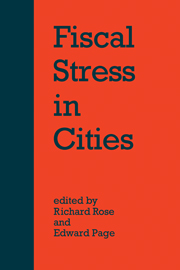Book contents
- Frontmatter
- Contents
- Acknowledgments
- 1 Can Government Control Itself?
- 2 Pressures in Whitehall
- 3 Pressures from Whitehall
- 4 The Decline of Urban Economies
- 5 Local Government as an Employer
- 6 Do Fewer Pupils Mean Falling Expenditure?
- 7 Local Autonomy and Intergovernmental Finance in Britain and the United States
- 8 Chronic Instability in Fiscal Systems
6 - Do Fewer Pupils Mean Falling Expenditure?
Published online by Cambridge University Press: 07 October 2011
- Frontmatter
- Contents
- Acknowledgments
- 1 Can Government Control Itself?
- 2 Pressures in Whitehall
- 3 Pressures from Whitehall
- 4 The Decline of Urban Economies
- 5 Local Government as an Employer
- 6 Do Fewer Pupils Mean Falling Expenditure?
- 7 Local Autonomy and Intergovernmental Finance in Britain and the United States
- 8 Chronic Instability in Fiscal Systems
Summary
Education now constitutes the most costly single service of local government, accounting for 36 per cent of its expenditure in England and Wales, claiming 41 per cent of current expenditure, and also 10 per cent of gross capital expenditure. Hence any developments affecting education will have considerable cost implications for overall local government expenditure.
The postwar period has seen educational expenditures rise as a result of both demographic push and increased spending per pupil. The total school population rose steadily until the late 1970s, reflecting the early post-war increase in the birth rate. Numbers in primary schools in England and Wales increased from 3.8 million in 1946 to a peak of 4.9 million in 1973, and secondary numbers from 1.2 million in 1946 to a peak of 4.1 million in 1979, including the effects of the raising of the school-leaving age in 1973. This growth entailed substantial and increasing levels of capital spending to meet basic need (i.e. the provision of more school places to cater for increases in the school population), and some attention was also given to the improvement of deteriorating facilities, such as old school buildings. Spending per pupil was increased, most notably by employing more teachers to reduce the pupil-teacher ratios (PTRs). By the early 1970s, current public expenditure on primary and secondary education amounted to 2.9 per cent of the Gross Domestic Product of the United Kingdom (OECD 1976).
- Type
- Chapter
- Information
- Fiscal Stress in Cities , pp. 137 - 167Publisher: Cambridge University PressPrint publication year: 1983



